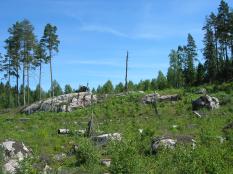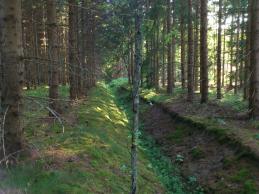Background & Aims
Background

Large scale natural disturbances such as fires, storms and insect outbreaks have long shaped the forested landscapes of northern Europe. The most important and profound effect in our Swedish coniferous forests is that of forest fires, and many species of both plants (e.g. fire resistant bark on Scots pine, Pinus sylvestris) and animals (e.g. pyrophilic beetles) have adapted to or even become dependent on it (e.g. Geranium lanuginosum) at some point in their life cycle. The threatened longhorn beetle Tragosoma depsarium is spread almost all over Sweden, with an exception for the southernmost counties and the mountain range. Adults are 20-30 mm long and emerges in July after about four years as a larvae that lived inside firm but bark-free, silver-coloured logs of Scots pine subjected to strong sun exposure. Logs in these conditions arises naturally after a forest fire, but can also be created by man in for example clear-cuts.
However, implementation of modern clear-cutting forestry and fire suppression during the 1900s have led to a recent, dramatic decline in numbers of the threatened longhorn beetle Tragosoma depsarium. One reason might be that very few logs and snags of pine are usually left on clear-cuts and the regenerating forest soon shadows the logs, killing any larva left. But perhaps the most important reason for this decline is that the forests becomes increasingly younger and denser with fewer and fewer really old pines. Provided continuous sun exposure, logs from these large and old (>200-250 years) pines could act as “buffering logs” for decades, i.e. persist as suitable breeding substrates during multiple generations and thus overcome periods when suitable logs are scarce.

Scale is also an important factor to take into consideration when assessing to what extent disturbances affect threatened animal populations, or how large a species’ population is. Knowing at what scale different species react on, whether it is square meters or hundreds of thousands of hectares, is vital for conservation biologists. Today more than 4,400 beetles live in Sweden, but one out of five is red-listed. A majority of the red-listed beetles are associated with old, dying or dead trees, the same group as T. depsarium is a part of. To better be able to help this species, a refreshed map of where it is present today, together with its associated landscape variable(s) at a correct scale, is needed.
Aims
- Map the distribution of the threatened beetle Tragosoma depsarium in Östergötland County as a part of a conservation program.
- Investigate the effect of the surrounding landscape at different spatial scales on the occurrence of T. depsarium.
» Are some identifiable elements or factors on each site of importance?
» Do the landscape around each site (i.e. within 100 m, 500 m, 1000 m or 2000 m) have a significant influence on a sites’ presence-absence of beetles?
Responsible for this page:
Director of undergraduate studies Biology
Last updated:
05/11/15
